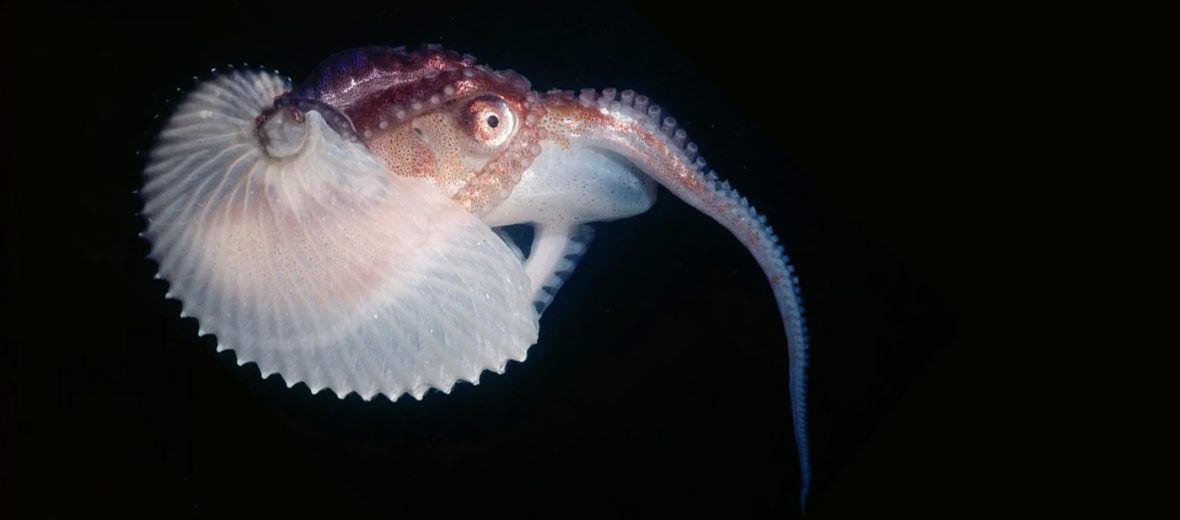
The argonaut, aka paper nautilus, is in a group of pelagic (upper layers of the open sea) octopuses. They get the common name paper nautili, due to the paper-thin eggcase that females produce. These fascinating creatures are generally listed as Least Concern or Data Deficient by the IUCN. But they do face the threats of overfishing, pollution, and climate change.
First the Stats…
Scientific name: Argonauta
Weight: Up to 3+ lbs.
Length: Up to 15+ inches
Lifespan: Up to 1 year
Now on to the Facts!
1.) Their shells are don’t have the gas-filled chambers located in chambered nautilus shells. Therefor they do not have a true cephalopod shell, but instead an evolutionary deviation that is unique to this genus.
2.) They not only use the shell as a brood chamber, but also to trap surface air in order to maintain buoyancy.
3.) It was once thought that argonauts utilized the egg cases of other animals to rear their young. However, in the early 19th century, marine biologist Jeanne Villepreux-Power disproved this theory by rearing argonaut young and then observed their shells’ development.
4.) These critters prefer tropical and subtropical waters, the world over.
5.) They have a rounded body, 8 limbs (arms) and lack fins.
But wait, there’s more on the argonaut!
6.) Argonauts swim by expelling water through their funnels, not by using their arms to propel themselves.
7.) Extreme sexual dimorphism in size and lifespan is characteristic in these critters. As females can grow shells to 11.81 inches, where males only grow to a mere .79 inch shells.
Did you know…?
Argonauts utilize their tentacles to grab prey and drag it towards the mouth. It then bites the prey to inject it with venom produced from their salivary gland.
8.) Males utilize a modified arm, called the hectocotylus, to transfer sperm to the female. During fertilization, the arm is inserted into the female’s pallial cavity and then is removed from the male.
9.) Their shells are not made of aragonite like most other shells are, but rather calcite. They also have a higher amount of magnesium carbonate (up to 7%) than other cephalopod shells have.
10.) The name “argonaut” means “sailor of the Argo.”
But wait, there’s still more on the argonaut!
11.) Small crustaceans, jellyfish, molluscs, and salps are all on the menu.
12.) If a prey item has a shell, the argonaut uses its radula to drill into the organisms carapace, then injects their venom to liquify the flesh inside.
Did you know…?
Females produce upwards of 140,000 eggs!
13.) Not only are they able to change their coloration to avoid predation, but they can also ink. When a cloud of ink is produced, it paralyzes the olfaction of the attacker allowing the argonaut time to escape.
14.) Tunas, billfishes, and dolphins all prey on the argonaut.
15.) The paper nautilus has also been featured in literature too, in such works as Marianne Moore’s poem “The Paper Nautilus,” Anne Morrow Lindbergh’s “Gift from the Sea,” Twenty Thousand Leagues Under the Sea, and The Swiss Family Robinson novel.
Now a Short Argonaut Video!
Be sure to share & comment below! Also, check out the Critter Science YouTube channel. Videos added regularly!
Want to suggest a critter for me to write about? Let me know here.
Some source material acquired from: Wikipedia & IUCN
Photo credit: Marevision/Getty Images



